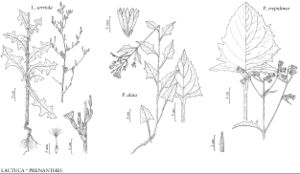Lactuca
Sp. Pl. 2: 795. 1753.
Gen. Pl. ed. 5, 348. 1754.
Annuals or biennials, 15–450+ cm; taprooted. Stems usually 1, usually erect, branched distally or throughout, glabrous or hairy (sometimes hispid to setose). Leaves basal and cauline or mostly cauline (at flowering); sessile or petiolate; blades orbiculate, ovate, oblong, or lanceolate to oblanceolate, linear, or filiform, margins entire or denticulate to pinnately lobed (faces glabrous or hairy, often ± setose). Heads borne singly or in corymbiform to paniculiform arrays. Peduncles not inflated distally, sometimes bracteate. Calyculi of 3–10+, deltate to lanceolate bractlets in 2–3 series (sometimes intergrading with phyllaries). Involucres campanulate to cylindric, 2–5 [–8+] mm diam. Phyllaries 5–13+ in ± 2 series (erect or reflexed in fruit), lanceolate to linear, usually subequal to equal, margins sometimes scarious, apices obtuse to acute. Receptacles flat to convex, pitted, glabrous, epaleate. Florets 6–50+; corollas yellow, bluish, or whitish. Cypselae reddish-brown, tan, whitish, or purplish to blackish, bodies compressed to flattened, elliptic to oblong, beaks stout (0.1–1 mm, gradually or weakly set off from bodies) or filiform (2–6 mm, sharply set off from bodies), ribs 1–9 on each face, faces often transversely rugulose, usually glabrous; pappi persistent (borne on discs at tips of cypselae or beaks), obscurely double (spp. 1–2), each a minute, erose corona 0.05–0.2 mm subtending 40–80+, white or fuscous, ± equal, barbellate to barbellulate bristles in 1–2 series, or simple (spp. 3–10) of 80–120+, white, ± equal, barbellulate to nearly smooth bristles in 2–3+ series. x = 9.
Distribution
North America, Mexico, Central America, Eurasia, Africa
Discussion
Species ca. 75 (10 in the flora).
The common head and leaf lettuces of home gardens and commerce are derived from Lactuca sativa.
Selected References
None.
Lower Taxa
Key
| 1 | Corollas usually bluish, sometimes white, rarely yellow, not or seldom deliquescent; cypselae ± compressed-lanceoloid to compressed-fusiform, beaks 0 or ± stout (gradually set off from bodies of cypselae), 0.1–0.5(–1) mm | > 2 |
| 1 | Corollas usually yellow, sometimes bluish (or drying bluish) or white, usually deliquescent; cypselae ± flattened, ± elliptic to obovate or oblanceolate, beaks ± filiform (sharply set off from bodies of cypselae), 1–4+ mm | > 3 |
| 2 | Florets (15–)20–30(–50+); pappi ± fuscous | Lactuca biennis |
| 2 | Florets 10–15(–25+); pappi white | Lactuca floridana |
| 3 | Faces of cypselae 1(–3)-nerved | > 4 |
| 3 | Faces of cypselae (3–)5–9-nerved | > 7 |
| 4 | Involucres 10–12 mm; cypsela bodies 2.5–3.5 mm | Lactuca canadensis |
| 4 | Involucres 12–20 mm; cypsela bodies 4.5–6 mm | > 5 |
| 5 | Leaves on proximal 1/3–1/2 of each stem, blades spatulate to lance-linear | Lactuca graminifolia |
| 5 | Leaves on proximal (1/3–)1/2–3/4 of each stem, blades ovate or oblanceolate to spatulate | > 6 |
| 6 | Margins of leaf blades entire or denticulate, seldom prickly; florets 12– 24+ | Lactuca hirsuta |
| 6 | Margins of leaf blades ± toothed, ± prickly; florets 20–50+ | Lactuca ludoviciana |
| 7 | Cypselae purplish to blackish, ± elliptic | Lactuca virosa |
| 7 | Cypselae pale brown to grayish or whitish, ± obovate or ± oblanceolate | > 8 |
| 8 | Blades of undivided leaves lanceolate to linear or filiform; heads in racemiform or spiciform arrays | Lactuca saligna |
| 8 | Blades of undivided leaves mostly ± oblong or mostly obovate to orbiculate; heads in corymbiform or paniculiform arrays | > 9 |
| 9 | Blades of cauline leaves usually ± oblong, sometimes narrowly obovate to lanceolate, midribs usually prickly setose, rarely smooth; phyllaries usually reflexed in fruit | Lactuca serriola |
| 9 | Blades of cauline leaves ovate to orbiculate, midribs usually smooth, rarely prickly setose; phyllaries usually erect in fruit | Lactuca sativa |
"fine" is not a number.

